
Health Testing, CHIC Testing, and Supported Research
The Pug Club of Canada supports and recommends all dogs used for breeding be screened for the following health issues.
- Hip Dysplasia – OFA Evaluation
- Patellar Luxation – OFA Evaluation
- OFA or CERF Eye Examination – annually by a boarded Ophthalmologist.
- Pug Dog Encephalitis (PDE) – DNA test for Necrotizing Meningoencephalitis
- Spine/ Hemi vertebrae – OFA Evaluation
- Pyruvate Kinase Deficiency (PKD) (Optional) – DNA based PKD test results from an approved lab
Common Eye Diseases in Dogs – By Jennifer Coates, DVM
A dog’s eyes perform a nearly miraculous function – converting reflected light into nerve impulses that the brain uses to form images of the world. To do this well, all the various parts of the eye must be healthy. Unfortunately, a number of diseases can disrupt the way a dog’s eyes function. Let’s take a look at some of the most common eye problems dogs experience and how pet parents can manage them.
Cherry Eye
Dogs have three eyelids – two that are readily visible and an extra one, called the third eyelid, that normally hides from view below the inner corner of the eye. The third eyelid is home to a tear producing gland. Normally, this gland is also invisible, but some dogs have a congenital weakness of the ligaments that hold it in place. When these ligaments fail, the gland pops out of its normal location and looks a bit like a “cherry” stuck at the inner corner of the eye. Because this condition often has a genetic basis, both eyes are usually affected over time.
To treat cherry eye, a veterinarian will perform a simple surgery to attach the gland back in a more normal position.
Corneal Wounds
The surface of the eye is covered with a clear, skin-like tissue called the cornea. Just like the skin, the cornea can be injured, and lacerations (cuts), punctures and ulcers are all quite common in dogs. Trauma is often to blame, like when a dog runs through tall grass and gets poked in the eye. In other cases, problems with the eyes themselves (like poor tear production or abnormal anatomy) can put dogs at risk for corneal damage. A dog with a corneal wound will often rub at the affected eye and squint because of pain. The eye may also be red and have excessive drainage.
Treatment for corneal wounds involves preventing or treating infections with antibiotic eye drops or ointments, managing pain and giving the cornea time to heal. In severe cases, surgery or other treatments may be needed to protect or repair the cornea and promote healing.
Keratoconjunctivitis Sicca (KCS) or Dry Eye
When dogs develop a disease called keratoconjunctivitis sicca (KCS) or dry eye, their tear glands produce fewer tears than normal. Tears perform important functions like removing potentially damaging material from the surface of the eye and nourishing corneal tissues. Unsurprisingly, a lack of tears can cause big problems including corneal ulcers, chronic drainage of mucus from the eyes and pain.
Mild cases of KCS can sometimes be managed with frequent application of an artificial tear solution, but medications that stimulate tear production (e.g., cyclosporine) are usually necessary. Surgery that redirects a duct carrying saliva so that it moistens the eye is an option in severe cases.
Conjunctivitis (Pink Eye)
The conjunctiva are the mucus membranes that cover the inside of a dog’s eyelids, both sides of the third eyelid and some parts of the eyeball. “Conjunctivitis” or “pink eye” are interchangeable terms that simply mean “inflammation of the conjunctiva.” The symptoms of conjunctivitis include reddened and swollen conjunctiva, eye drainage and discomfort.
Conjunctivitis should be thought of as a symptom of disease, not a disease itself. Many conditions cause conjunctivitis in dogs, including physical irritation (like dust and inward growing eyelashes), infections (bacterial and viral are most common) and allergic reactions. Treatment depends on the underlying cause. Sterile saline eye washes are available over the counter and can be used to flush irritants from the eye. Bacterial eye infections usually resolve quickly when treated with an appropriate prescription antibiotic eye drop or ointment. The chances of catching pink eye from your dog is very low but it only makes sense to wash your hands thoroughly after applying your dogs eye medications. Make a veterinary appointment if your dog’s conjunctivitis worsens or fails to resolve over the course of a day or two.
Glaucoma
Within the eye, the production and drainage of fluid is precisely balanced to maintain a constant pressure. Glaucoma occurs when this balance is disrupted and pressure within the eye increases. Symptoms include pain, eye redness, increased tear production, a visible third eyelid, corneal cloudiness, dilated pupils and in advanced cases, an obviously enlarged eye.
Call your veterinarian immediately if you are worried that your dog might have glaucoma because delaying treatment can result in blindness. Treatment may involve a combination of topical and oral medications that decrease inflammation, absorb fluid from the eye, lower fluid production within the eye and promote drainage of fluid from the eye. Surgery may also an option in some cases.
Cataracts
The lens is located in the middle of the eye and it is normally clear, but sometimes part or all of a lens develops a cloudy, opaque cataract. Cataracts block light from reaching the back of the eye resulting in poor vision or blindness, depending on their severity. Cataracts are often confused with a normal aging change that affects a dog’s lenses called lenticular sclerosis. Both conditions give the pupils (the normally black center to the eye) a white, grey, or milky appearance, but a veterinarian can tell the difference through a standard eye exam.
Cataract surgery is available for dogs when their vision is severely compromised. If this is not an option, it is important to recognize that most dogs adapt very well to having poor vision.
Pigmentary Keratopathy (PK) – By Dr. Amber Labelle, DVM
Pigmentary keratopathy (PK) is the most prevalent eye disease of the pug breed. Pigmentary keratopathy (PK) is a condition in which brown pigment progressively clouds the cornea, the clear tissue that allows light to enter the eye. PK often results in partial or complete blindness. For more on this condition click here!
Talk to Your Veterinarian
It is very important to discuss any concerns that you might have about your dog’s eyes with your veterinarian as quickly as possible.
BOAS/ BAOS… What is that?
“Brachycephalic airway obstruction syndrome (BAOS) or Brachycephalic Obstructive Airway Syndrome (BOAS) occurs in all breeds with significant brachycephaly. Brachycephaly is abnormally short head shape (compared with the ancestral, natural, head shape of dogs) with, in some cases, greatly shortened upper jaws and noses. BOAS refers to the suite of respiratory problems associated with brachycephaly. Although the facial bones are shortened, the soft tissues inside remain unchanged in size and are thus squeezed into a substantially smaller space. This leads to narrowing, and increased resistance to airflow, in the nose and upper airways. BOAS describes the clinical signs due to these effects. The main congenital (present from birth) abnormalities are stenotic nares (abnormally narrow nostrils) and elongated and thick soft palate. (Tracheal hypoplasia (abnormally narrow windpipe) is rare in the pug). The permanent narrowing and obstruction of the airways makes breathing much harder. In time, the effects of the increased respiratory effort leads to secondary changes which further narrow the air passages, and may contribute to the collapse of the larynx (the voice box at the entrance of the windpipe). BAOS leads to snoring, respiratory noise, mouth breathing, and respiratory distress with rapid breathing and struggling for breath, and can lead to collapse and death. Dogs with BOAS are unable to take even moderate amounts of exercise, are very prone to heat stroke and have disrupted sleep.” Excerpt from Universities Federation for Animal Welfare
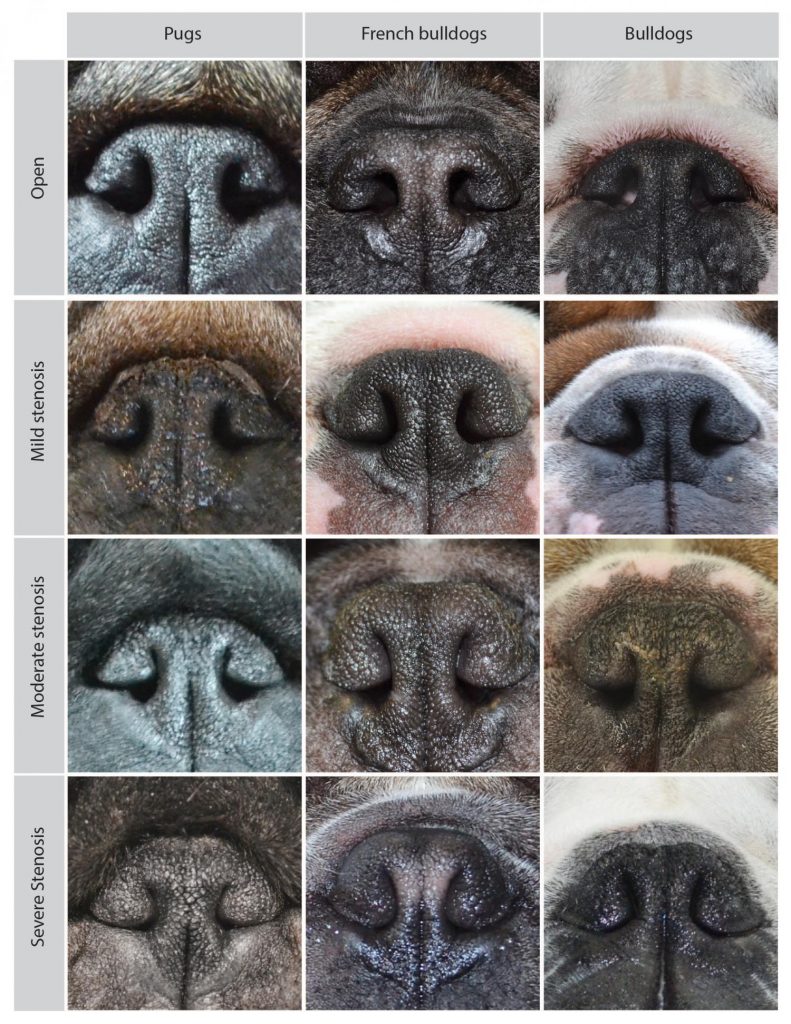
For more information please click on BAOS .
BOAS Grading Scheme for Pugs
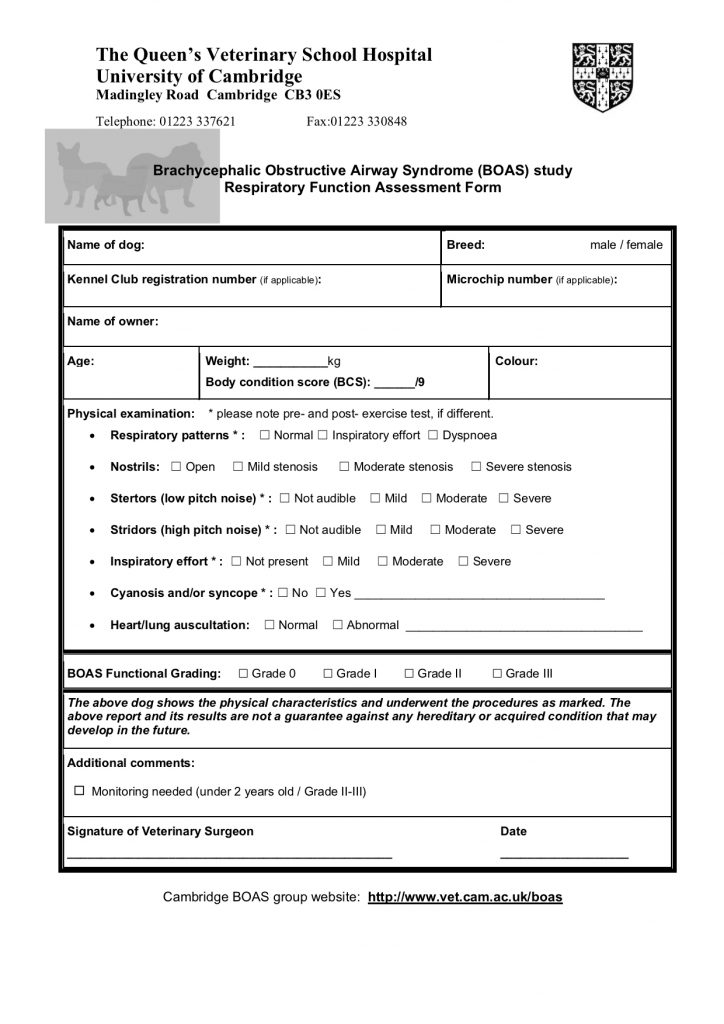
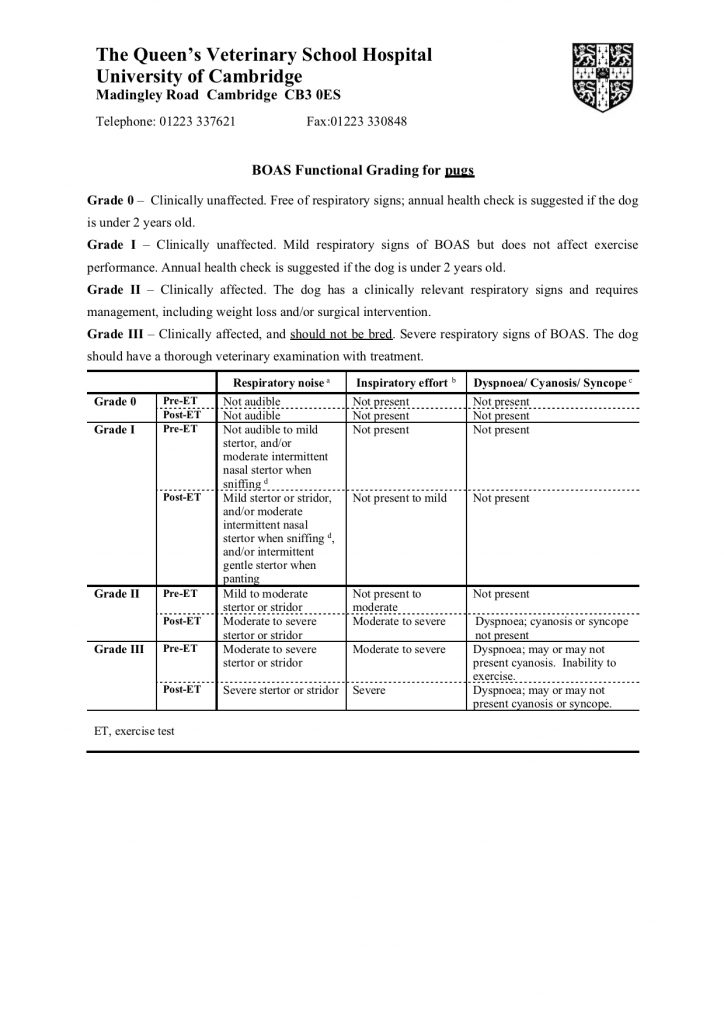
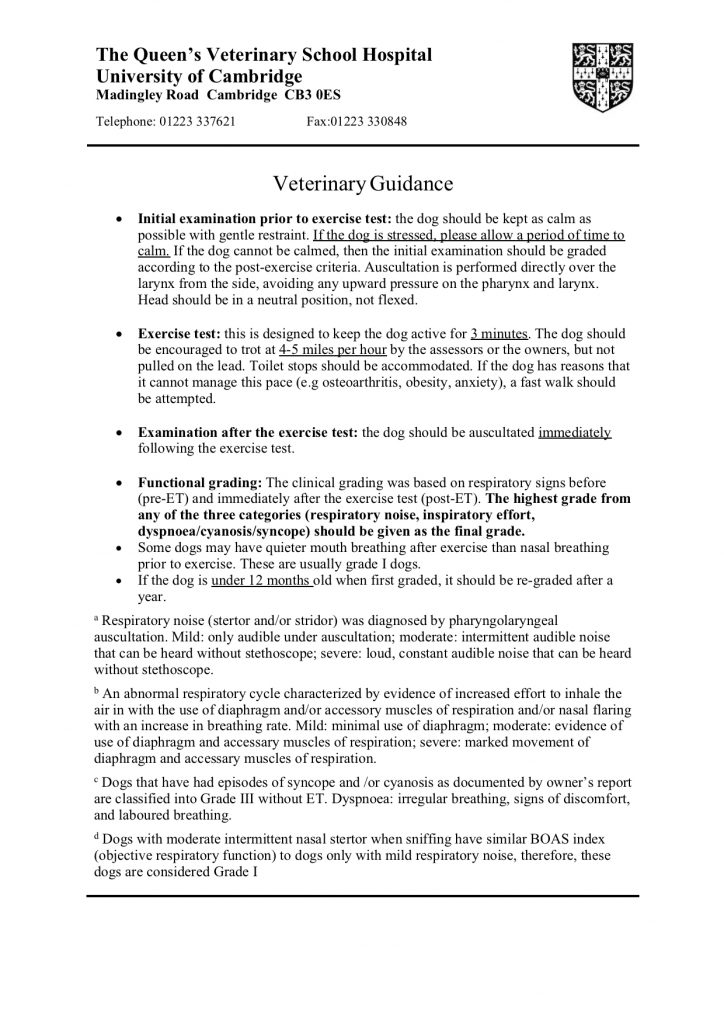
Pug Myelopathy
“Pug Myelopathy is a recently recognized spinal condition believed unique in Pugs. It is called by several terms, and it is most often referred to as “Pug Myelopathy”. Pug Myelopathy is considered the most frequent cause of rear limb incoordination (ataxia) and progress to paralysis of the rear limbs over a period of one to four years. Originally referred to as “Weak Rear”, this has become a widespread problem in Pugs. The rear legs appear to be weak, but the cause is a neurological deficit that develops in the spine. Affected dogs may initially drag their feet, stagger, have trouble jumping and can be fecal and urinary incontinent. It usually affects just the rear limbs, unlike a very different disease, Degenerative Myelopathy (DM), which can have similar initial signs, but progresses tragically to complete paralysis and death. In Pug Myelopathy, we are learning there is usually a complex of spinal abnormalities that involve both the vertebral bones, and can also involve compression of the spinal cord. The compression can be caused by one (or multiple lesions) that include one or multiple sites of chronic Hansen type II intervertebral disc disease (IVDD); spinal arachnoid diverticulum (SAD); spinal cord atrophy; and fibrosis of the arachnoid layer of the meninges. Unraveling the relationships between these conditions is one goal of the research at Michigan State University funded by the Pug Dog Club of America.
Other names that refer to Pug myelopathy include “Pug constrictive myelopathy (CM)”, “facet hypoplasia”, “subarachnoid diverticulum (SAD)” and others. Although little is published about this condition, Pug Myelopathy may be the most common cause of mid-back spinal cord problems in Pugs.
Another good description of the disease is provided by Southeast Veterinary Neurology, Wong M, (2017). Case History of Surgical Treatment for Pug Myelopathy. Available at: www.sevneurology.com/patients/wellington/ [Accessed 10 Jul. 2017].
Many veterinarians are not yet knowledgeable about this condition, as published information is not yet widely available. Pugs with rear limb ataxia may have had a previous diagnosis that was incomplete in light of this evolving information. Since so little is known, there is no consensus among neurologists about the best way to treat it. Surgery may be appropriate for individual cases, but it must be considered as soon as possible, after symptoms first occur, and may only delay progression of paralysis.
The most important palliative treatment appears to be consistent physical therapy using rehabilitation exercises to preserve muscle strength and enhance development of a spinal walk. A wheeled cart, carefully fitted by a knowledgeable professional, may improve their ability to walk. Other forms of integrative medicine can enhance their ability and desire to stay mobile. Pugs affected with Pug Myelopathy are usually pain free and can lead excellent long lives with good nursing care. All senior Pugs require periodic wellness exams to detect and alleviate other problems of aging using medication and/or supplements. It is critical the Pug is carefully monitored for its ability to completely empty the urinary bladder several times a day. Several other well documented conditions in Pugs also cause symptoms of ataxia, including hemivertebrae (usually young dogs); acute sudden onset Intervertebral Disc Disease (IVDD) or “slipped disc” – (usually painful); spinal cord tumors; and spinal arthritis in elder dogs. It is important to have your primary care veterinarian arrange a referral for your Pug for an examination by a board certified veterinary neurologist or surgeon when symptoms of ataxia first appear.”
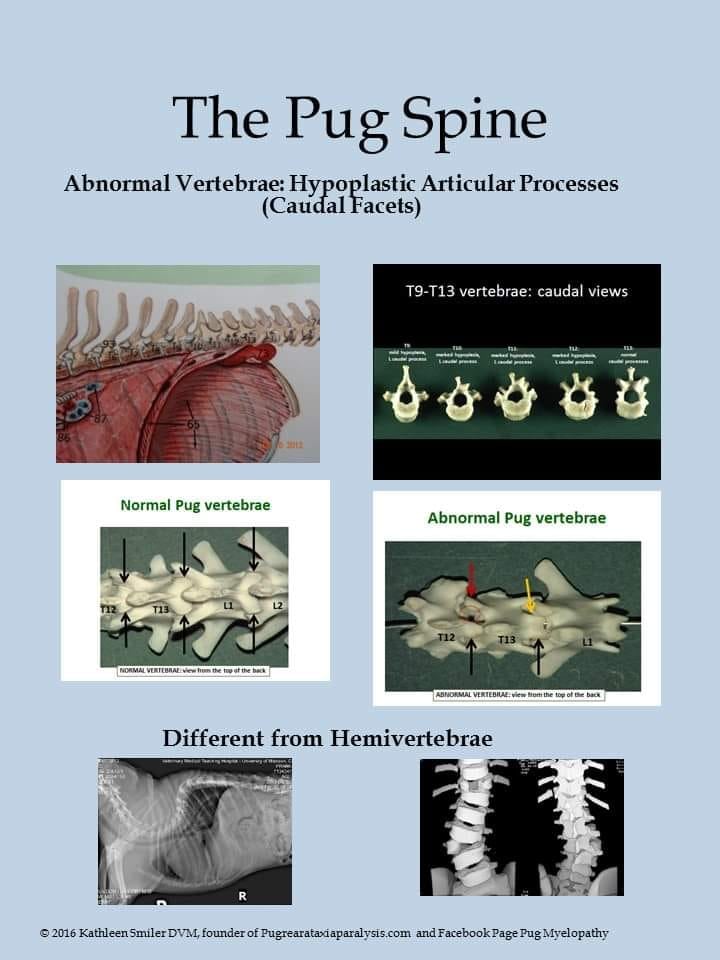
For More Information about Pug Myelopathy
Kathleen L. Smiler, DVM, DACLAM
PO Box 429
Lakeville, MI 48366
248-953-3182 FAX 248-751-5900
smilerk@mindspring.com
pugrearataxiaparalysis.com/
www.facebook.com/Pug-Dog-Health-Rear-AtaxiaParalysis-218123938233440/
Pug Myelopathy Project at MSU on AVMA Clinical Study Database: ebusiness.avma.org/aahsd/study_search_detail.aspx?sid=312
Wonderful Support Group www.facebook.com/groups/wheeliepugs/
The above text on Pug Myelopathy was taken from the PDCA Website under their Health Section.
Allergies
Dog Allergies – Symptoms and Treatment Have you heard someone tell you that their dog has allergies? Has your veterinarian suggested that allergies could be a problem for your dog? Do you suspect that your dog has allergies? If so, then you’ve probably realized that allergies in dogs are not quite as simple as we might wish. For starters, there are several different types of allergies that could be causing your dog’s symptoms.
Types of Allergies – in Dogs Allergies are a misguided reaction to foreign substances by the body’s immune system, which, of course, people and pets can suffer from. There are quite a few different types of allergies in dogs. Skin allergies, food allergies, and environmental allergens all pose challenges for dogs and their owners, and to make things more complicated, the symptoms of all these different types of allergies can overlap.
Skin Allergies – Skin allergies, called allergic dermatitis, are the most common type of allergic reactions in dogs. There are three main causes of skin allergies in dogs:
1. Flea allergy dermatitis
2. Food allergies
3. Environmental allergens
Flea allergy dermatitis is an allergic reaction to fleabites. Some dogs are allergic to flea saliva. This makes affected dogs extremely itchy, especially at the base of the tail, and their skin may become red, inflamed, and scabbed. You may also notice signs of fleas, such as flea dirt, or even see the fleas themselves.
Food allergies and sensitivities can cause itchy skin, as well. The most common places dogs with food allergies itch are their ears and their paws, and this may be accompanied by gastrointestinal symptoms.
Environmental allergens, such as dust, pollen, and mold, can cause an atopic allergic reactions or atopic dermatitis. In most cases, these allergies are seasonal, so you may only notice your dog itching during certain times of the year. As with food allergies, the most commonly affected areas are the paws and ears (but also include the wrists, ankles, muzzle, underarms, groin, around the eyes, and in between the toes).
All skin allergies pose the risk of secondary infection. As your dog scratches, bites, and licks at his skin, he risks opening up his skin to yeast and bacterial infections that may require treatment.
Food Allergies
True food allergies may not be as common as people think, according to AKC Chief Veterinary Officer Dr. Jerry Klein. True food allergies result in an immune response, which can range in symptoms from skin conditions (hives, facial swelling, itchiness), gastrointestinal signs (vomiting and/or diarrhea) or a combination of both. In some rare cases, a severe reaction resulting in anaphylaxis can occur—similar to severe peanut allergies in humans but what about all of those dogs that are on special hypoallergenic dog food diets?
What most people mean when they say that their dog has a food allergy is that their dog has a food sensitivity, also known as a food intolerance. Food sensitivities, unlike true allergies, do not involve an immune response and are instead a gradual reaction to an offending ingredient in your dog’s food, for example to beef, chicken, eggs, corn, wheat, soy, or milk.
Dogs with food sensitivities can present with several symptoms, including gastrointestinal signs such as vomiting and diarrhea, or dermatological signs like itchiness, poor skin and coat, and chronic ear or foot infections.
The best way to diagnose and treat a food allergy is to work with your veterinarian to manage your dog’s symptoms and discover the ingredient causing the reaction.
Acute Allergic Reactions
Perhaps the most alarming of all the types of allergies in dogs is an acute allergic reaction. Dogs, like people, can go into anaphylactic shock if they have a severe reaction to an allergen. This can be fatal if not treated.
Bee stings and vaccine reactions, among other things, can cause an anaphylactic response in some dogs, which is why it is always a good idea to keep a close eye on your dog following the administration of any new vaccine, drug, or food item. Luckily, anaphylactic reactions are rare in dogs.
Your dog may also develop hives or facial swelling in response to an allergen. Swelling of the face, throat, lips, eyelids, or earflaps may look serious, but is rarely fatal, and your veterinarian can treat it with an antihistamine.
Symptoms of Allergies in Dogs
The symptoms of allergies in dogs may vary depending on the cause. A dog that goes into anaphylactic shock, for instance, will have a drop in blood sugar followed by shock, which is very different from a skin condition.
In general, however, the following symptoms could be a sign of an allergic reaction.
• Itchiness
• Hives
• Swelling of the face, ears, lips, eyelids, or earflaps
• Red, inflamed skin
• Diarrhea
• Vomiting
• Sneezing
• Itchy ears
• Chronic ear infections
• Itchy, runny eyes
• Constant licking
Some of these symptoms could also be a sign of another condition. Make an appointment with your veterinarian to get an accurate diagnosis and to help your dog start feeling better.
Diagnosing Allergies in Dogs
If you have ever undergone allergy testing, then you know that diagnosing allergies is often complicated.
The first thing your veterinarian may choose to do is rule out any other condition that could be causing your dog’s symptoms. If your veterinarian feels that an allergy is a likely cause, he or she may propose allergy testing to try and determine the cause of the allergen that is causing the reaction. However, keep in mind it may not always be possible to determine the cause of an allergy with testing.
Food allergies are often diagnosed using an elimination diet. A food trial consists of feeding a dog a novel (i.e. one) source of protein and carbohydrate for 12 weeks.
Flea allergy dermatitis is typically the easiest allergy to diagnose. It is usually diagnosed by identifying fleas on your dog’s body and applying a product that kills fleas before they can bite to see if that solves the issues. (Speak to your Veterinarian about the best choice for your pet)
Treating Allergies in Dogs
The best way to treat an allergy is avoidance of the cause and allergen. This may or may not always be possible. But, in terms of treatment, it depends on your dog’s type of allergy. For example, the best way to treat flea allergy dermatitis is to kill the fleas, whereas the best way to treat a food allergy or food intolerance is a change in diet.
In addition to any lifestyle changes that might be necessary, your veterinarian may also prescribe an allergy relief medication for your dog that will help control the signs associated with the allergic reaction, such as itching and any secondary skin infections that might have developed as a result of the irritant.
If your dog has a severe allergic reaction, your best course of action is to get him to an emergency veterinary hospital as quickly as possible.
Credit: American Kennel Club

